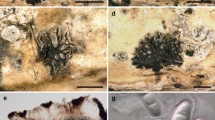Abstract
Diversities in fungi are manifold. Fungi themselves are heterogeneous and constitute at least three unrelated major taxa. Structural diversity reflects, in most cases, adaptive and functional strategies. Diversity in nucleic acids and chemical compounds is very high in several fungal taxa. Fungi play an essential role in the function of ecosystems. The diversity of plant parasites is extremely high and species-dependent associations exist. Saprobic fungi are most important in wood and litter decay and diverse taxa comprise the main decomposers in specific successional niches. Two dominating symbiotic systems have evolved convergently in various fungal groups, notably lichens and mycorrhizas, both remarkably diverse in their heterotrophic partners.
Similar content being viewed by others
References
Braun, U. (1987) A monograph of theErysiphales (powdery mildews).Beiheftzur Nova Hedwigia 89, 1–700.
Couch, J.N. (1938)The genus Septobasidium. Chapel Hill, N.C.: University of North Carolina Press.
Eriksson, J. (1950)Peniophora Cke. sect.Coloratae Bourd. & Galz. A taxonomical study with special reference to the Swedish species.Symb. Bot. Upsal. 5, 1–76.
Eriksson, J., Hjortstam, K. and Ryvarden, L. (1978)The Corticiacea of North Europe. Vol. 5. Oslo: Fungiflora.
Gäumann, E. (1959) Die Rostpilze Mitteleuropas.Beitr. Kryptfl. Schweiz 12, 1–1407.
Galloway, D.J. (1992) Biodiversity: a lichenological perspective. Biodiv. Conserv.1, 312–23.
Hafellner, J. (1984) Studien in Richtung einer natürlicheren Gliederung der Sammelfamilien Lecanoraceae und Lecideaceae Beiheftzun.Nova Hedwigia 74, 241–371.
Hawksworth, D.L. (1991) The fungal dimension of biodiversity: magnitude, significance, and conservation.Mycol. Research 95, 641–55.
Hennen, J.F. and Freire, F.O. (1979)Apra, a new genus ofUredinales onMimosa from Brazil.Mycologia 71, 1053–7.
Hirata, K. (1976) Notes on the host range and geographic distribution of the powdery mildew fungi, VI. Distribution of the hosts of powdery mildew fungi in the families of angiosperms.Trans. Mycol. Soc. Japan 17, 35–62.
Karling, J.S. (1977)Chytridiomycetarum iconographia. Vaduz: J. Cramer.
Kern, F.D. (1983)A revised taxonomic account of Gymnosporangium. Philadelphia: Pennsylvania State University Press.
Kukkonen, I. (1963) Taxonomic studies on the genusAnthracoidea (Ustilaginales).Ann. Bot. Soc. Fenn. Vanamo 34, 1–122.
Lichtwardt, R.W. (1986)The Trichomycetes. Fungal associates of Arthropods. New York: Springer-Verlag.
Martini, A. (1992) Biodiversity and conservation of yeasts. Biodiv. Conserv.1, 324–35.
Nannfeldt, J.A. (1979)Anthracoidea (Ustilaginales) onCarex subgen.Vignea with special regard to the nordic species.Bot. Notiser 130, 351–75.
Nannfeldt, J.A. (1981)Exobasidium, a taxonomic reassessment applied to the European species.Symb. Bot. Upsal. 23, 1–72.
Oberwinkler, F. (1984) Fungus-alga interactions in basidiolichens.Beiheftzur Nova Hedwigia 79, 739–774.
Pawsey, R.G. (1971) Some recent observations on decay of conifers associated with extraction damage, and on butt rot caused byPolyporus schweinzii andSparassis crispa.Quart. J. Forest. 65, 193–208.
Savile, D.B.O. (1976) Evolution of the rust fungi (Uredinales) as reflected by their ecological problems.Evol. Biol. 9, 137–207.
Savile, D.B.O. (1979) Fungi as aids in higher plant classification.Bot. Rev. 45, 377–503.
Seifert, K.A. (1983) Decay of wood by theDecrymycetales.Mycologia 75, 1011–8.
Shields, J.K. and Shieh, M. (1975) Catalogue of reference culture collection of wood-inhabiting microorganisms. Ottawa: Eastern Forest Products Laboratory Report OPX9E (revised).
Siepmann, R. (1977)Formes annosus (Fr.) Cke. und andere Stammfäuleerreger in einem Douglasienbestand (Pseudotsuga menziesii (Mirb.) Franco).Eur. Forest Pathol. 7, 203–10.
Siepmann, R. (1979) Stamm- und Wurzelfäulen in DouglasienPseudotsuga menziesii (Mirb.) Franco.Eur. J. Forest Pathol. 9, 70–8.
Vanky, K. (1985) CarpathianUstilaginales.Symb. Bot. Upsal. 19, 1–309.
Vanky, K. (1987)Illustrated genera of smut fungi. Stuttgart: G. Fischer Verlag.
Author information
Authors and Affiliations
Rights and permissions
About this article
Cite this article
Oberwinkler, F. Biodiversity amongst filamentous fungi. Biodivers Conserv 1, 293–311 (1992). https://doi.org/10.1007/BF00693766
Received:
Accepted:
Issue Date:
DOI: https://doi.org/10.1007/BF00693766




